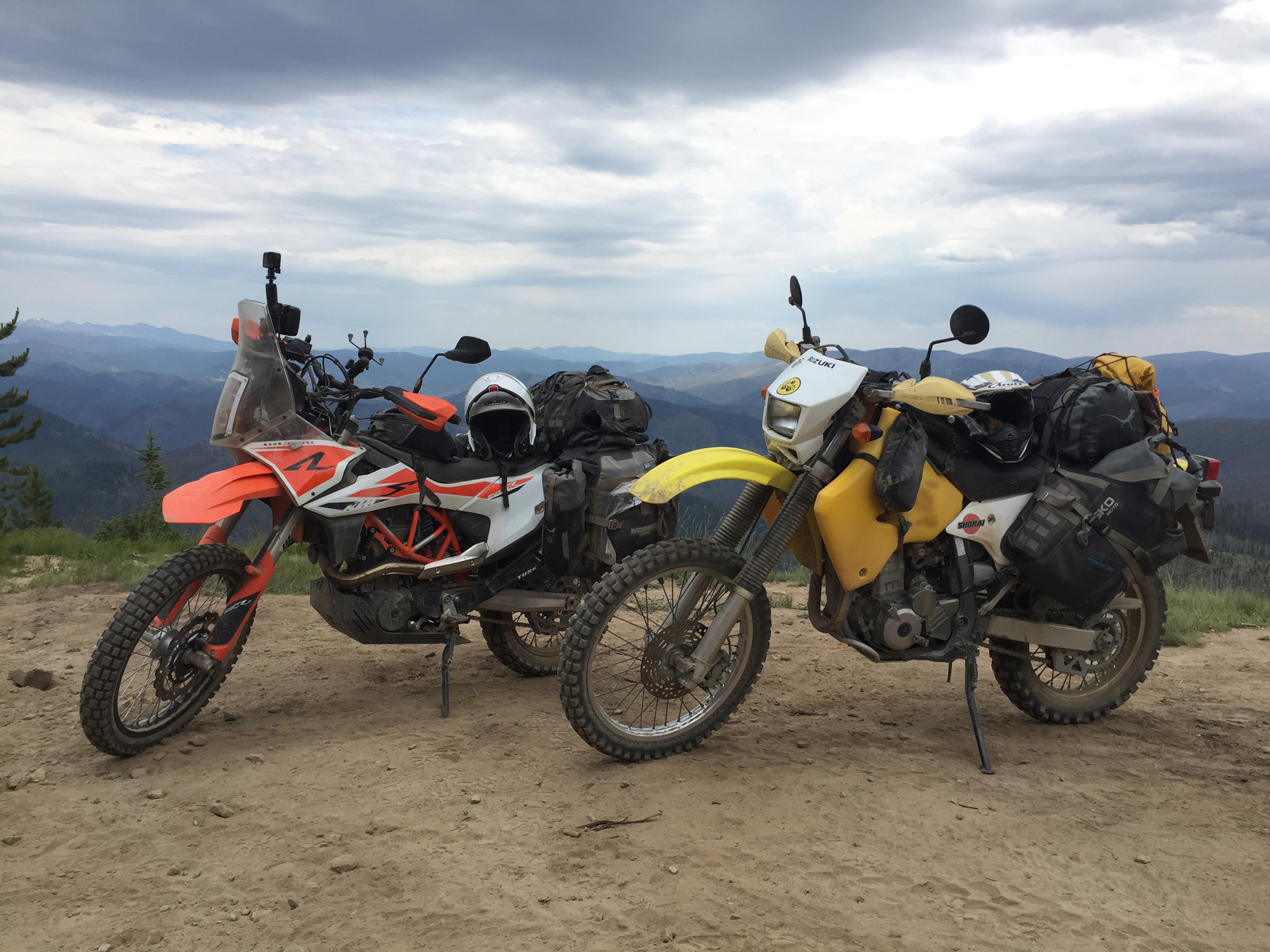From scrublands to high mountain forests, the Idaho BDR challenges motorcycles, riders, and gear.
After purchasing a BMW F 800 GS in 2009, I quickly sourced a set of expensive aluminum panniers, thinking that’s what you had to use on a GS. Victims of their own mass and structure, combined with progress in the textile world—namely waterproof soft luggage at a fraction of their weight and cost—those metal boxes have been collecting dust for over a decade. My first soft bag, the original 50-liter Giant Loop Great Basin, weighed less fully packed than the metal system does empty, an important consideration for overlanding. Not to mention the bone-crunching potential of metal panniers if one lands on your leg in a get-off. And fabric doesn’t dent.
To be fair, hard luggage still boasts some advantages—security being foremost for many riders. But locks can be picked, and newer soft bags can be cabled to your motorcycle. Ease of installation and removal is won by hard pannier designs using keyed-to-ignition locks and quick disconnects, though some boxes use less convenient interior-access mounting systems. Likewise, soft luggage can have an excess of straps, buckles, and clips that require daily attention, or mount simply and securely with just three straps.

Built for the long haul, Giant Loop’s Siskiyou panniers were an excellent choice for the Utah BDR and the 800-mile return to California via Nevada backroads.
Metal boxes do make better camp stools. Even so, my long experience with soft luggage, desire for lighter loads, and penchant for off-pavement travel have made me a convert. For sale: F 800 GS aluminum panniers.
Luggage Selection
I chose five sets of the highest quality soft luggage with 70-80 liters of storage, adequate for most rides of a week or more, and ride tested them on my GS. If the desired luggage didn’t support that volume, an additional bag was selected to supplement it. Some systems are rackless; others require a rack for support. For those requiring a rack, I sourced the Touratech stainless steel model, which adds 9 pounds to a luggage system. Although racks provide more support than hanging soft bags across the seat and tethering them with straps, modern rackless systems mount just as securely to the motorcycle and are lighter overall.
Testing
Testing began with an examination of each article for material and construction quality. Luggage was then packed with the 48-pound load I carried for 800 miles of the Idaho Backcountry Discovery Route (BDR) last summer and secured per manufacturer instructions. I unloaded and reloaded the luggage as if camping, then removed it from the motorcycle and replaced it to simulate a night in a motel. Ride testing included freeway, canyons, and rough roads. Due to California’s fires and forest closures, not all luggage was run on dirt, but there is plenty of potholed pavement in the Golden State to give things a good bounce assessment. I noted whether each system stayed secure, if it hampered me from shifting position on the bike, its width versus that of the GS handlebars (38 inches with Barkbusters), and how it affected the motorcycle’s handling. The waterproofing test used a garden hose to simulate hard rain and road spray, and all models passed.
Giant Loop | Siskiyou Panniers
Giant Loop of Bend, Oregon, made their mark on motorcycle luggage in 2008 with their original horseshoe-shaped, woven fabric saddlebag; the Great Basin model arrived in 2009 with the first use of vinyl-coated polyester with ballistic nylon reinforcements, plus military-grade components. Giant Loop’s Siskiyou panniers use those same materials in a design similar to hard panniers. As waterproof as metal boxes, the Siskiyous weigh only 9.5 pounds and measured 36 inches across on my BMW. Rackless by design, they can also be used with a rack.
Setup begins by joining the panniers over the seat via large, Velcro-equipped panels. A custom fit is possible by experimenting with the panels’ angle and width; once joined, the Siskiyous are easily removed and reinstalled. A heavy-duty Velcro strip connects the panel assembly to a rack plate or grab bar at the rear, with a stabilizing strap securing each pannier to a forward attachment point. Two wide support straps across the top prevent the panels from separating, and the bags are protected from melting on hot exhaust pipes by the included two Giant Loop Hot Springs heat shields.
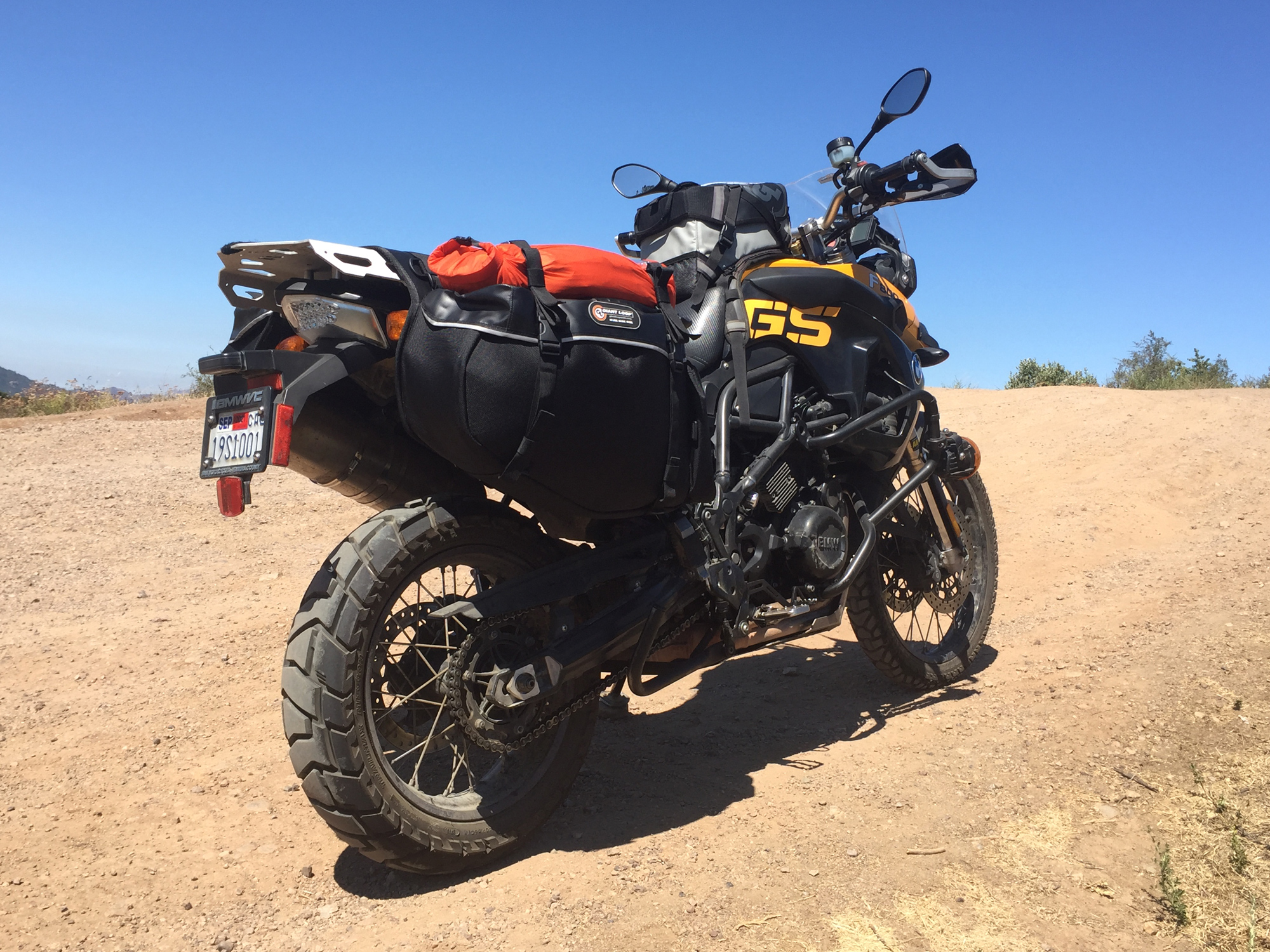
Siskiyou panniers handle extra gear with secure top straps and a wide, flat platform across the rear of the motorcycle.
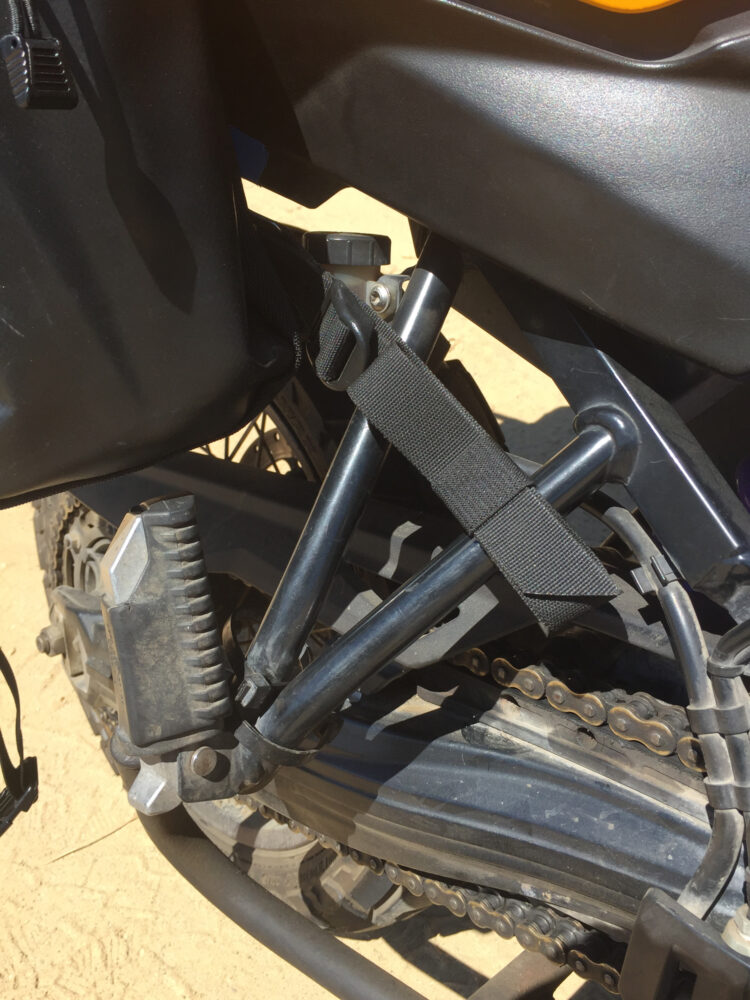
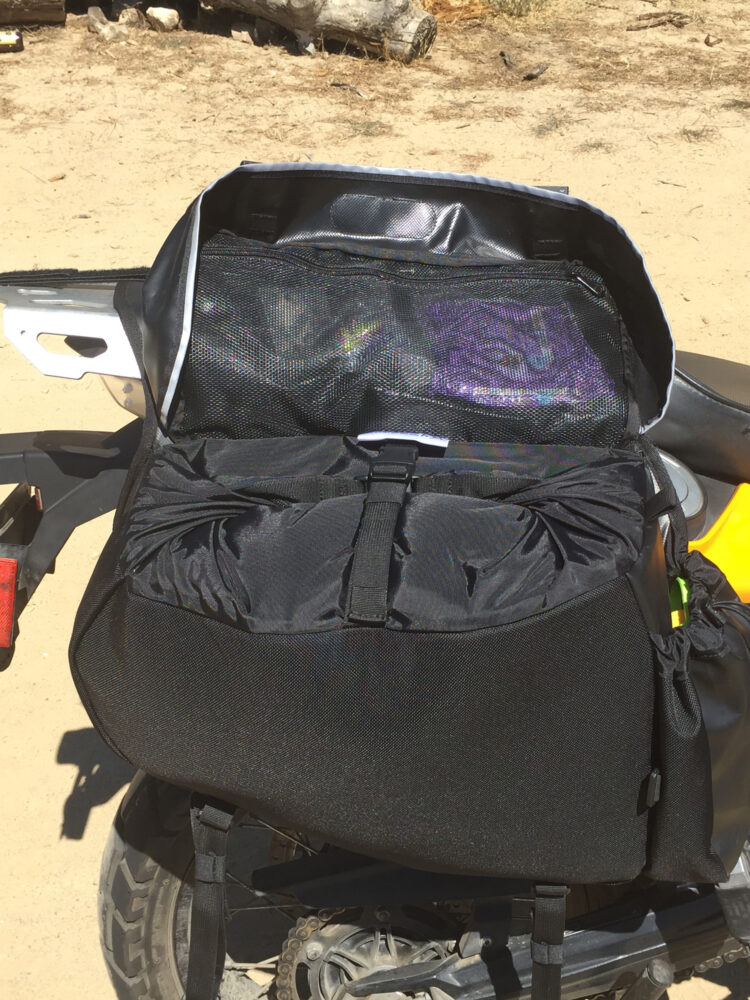
Left: Each pannier attaches forward with a sturdy strap while a single rear strap tensions the load, keeping them in place over rough terrain.
Right: A mesh pocket inside the lids provides easy-access storage for small items.
The Siskiyous have zippered roll-top extensions that allow some overstuffing, and each comes with a removable, waterproof, yellow “pod” to simplify packing. The pods’ wide openings take some practice to roll up neatly. Pannier tops fasten with two straps and overhang the bags by 3 inches to fend off dust and water; zippered mesh pockets on their undersides keep small items handy. Their shape is enforced by interior plastic panels and a strap across the roll top. On the front of each pannier is a drawstring pocket that will hold a 2-liter water or fuel bottle. The 70-liter Siskiyous took on all of my Idaho gear except a chair and air mattress; those items rode atop the right pannier using the metal-buckled straps. Panel-mounted D-rings provide additional lashing points, while security cable passages run beneath the panels.
The ride test confirmed my experience on the Utah BDR with an earlier version of the Siskiyous—they are stable on the bike and hang tough over the roughest ground, with no shifting or swinging to disturb the bike or rider. The inner sanctum of the pods is buried three straps, two roll tops, and a zipper deep, so the outer pockets held my water and energy bars. With everything sealed up, rain and road spray had no way in. Overall, the made-in-USA Siskiyou system is light, convenient, sturdy, and ready to travel. Available in black, orange, and gray, they carry a limited lifetime warranty.
$700 | GIANTLOOPMOTO.COM
Kriega Overlander-S | OS-32 And OS-12
Kriega is a British company dedicated to creating top-quality soft luggage, regardless of cost. Their Overlander-S (OS) series of five bags all spring from the same rectangular-shaped mold. It’s a clean design that lends itself to easy packing and storage when off the bike. I sourced two of the OS-32 (liter) panniers (an OS-22 is also available), supplementing them with an OS-12 Adventure Pack, one of three smaller offerings suitable for a pannier topper, tank bag, or tail pack (my choice). Built for adventure from Hypalon and 1000D Cordura, the OS-32s mount to the bike by aluminum alloy G-hooks. Sixteen Hypalon-lined Kevlar loops are deployed as anchors for extra gear, and optional shoulder straps can be fitted to dedicated attachment points. Roll-top designs rule for keeping water at bay, and Kriega luggage is no exception, enforcing a three-roll closure with short, non-adjustable side-release buckle straps. Inside is a removable, waterproof, white fabric lining.
The OS-32s require a rack, whether mounted over the saddle using Kriega’s OS straps or using their OS platforms clamped to the rack. I chose the CNC-machined nylon-6 platforms (7/16 inches thick, 2.6 pounds each), which can also carry a Rotopax fuel cell. The stout panniers are nearly 6 pounds apiece, with the 1.9-pound OS-12 bringing the total weight to 18.9 pounds; the rack weight makes them the heaviest by far. They span 40 inches on my GS; fitting an OS-22 to the exhaust side narrows that by 1.6 inches.
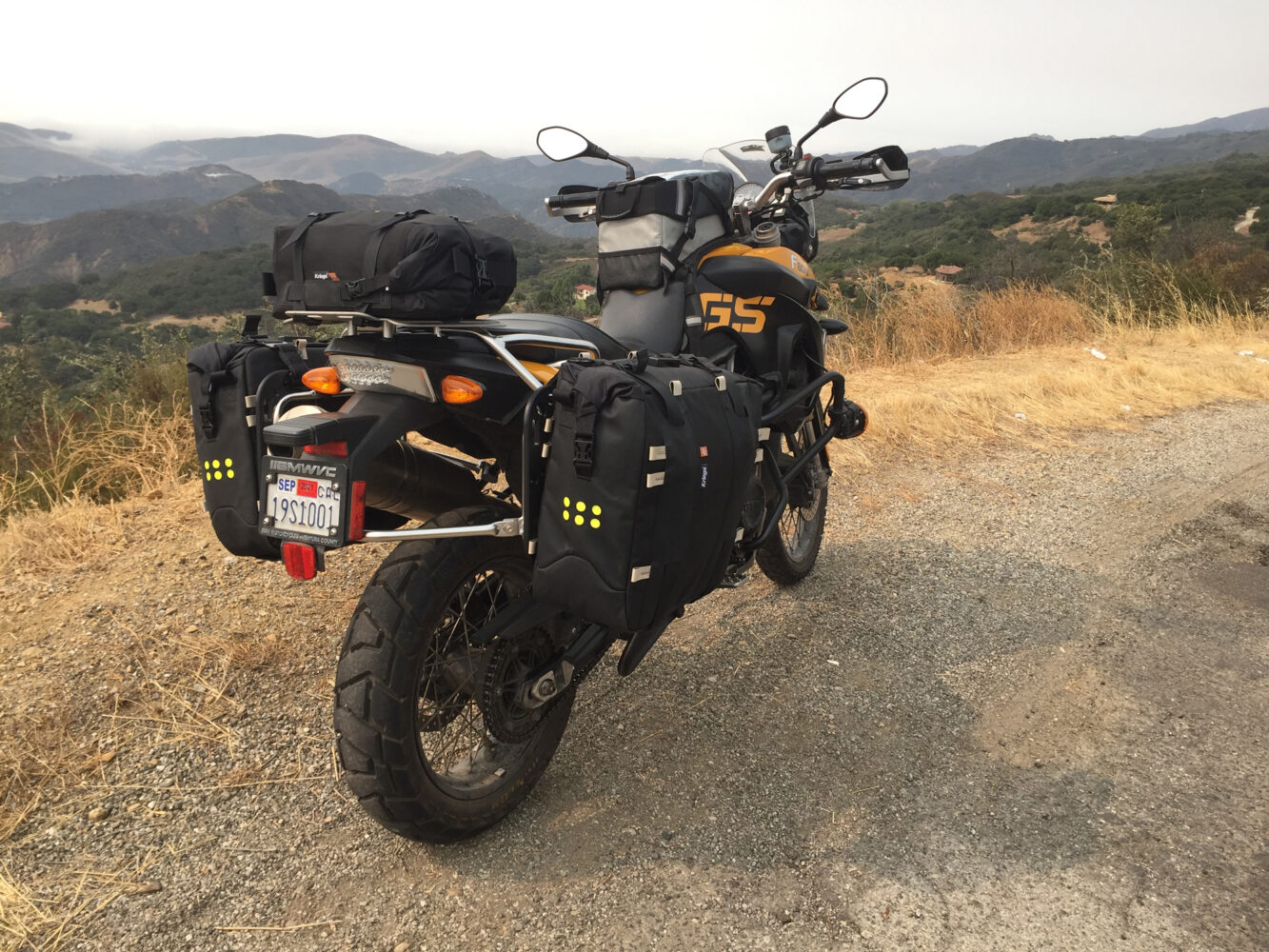
Overlander system bags use clean rectangular shapes for a neat look.
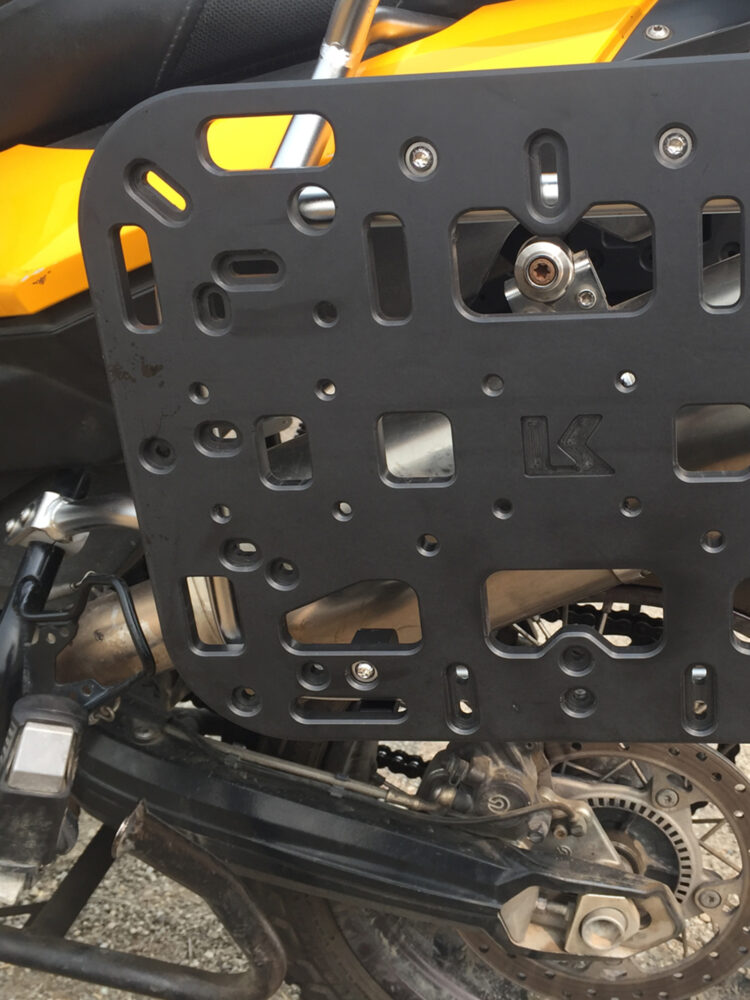
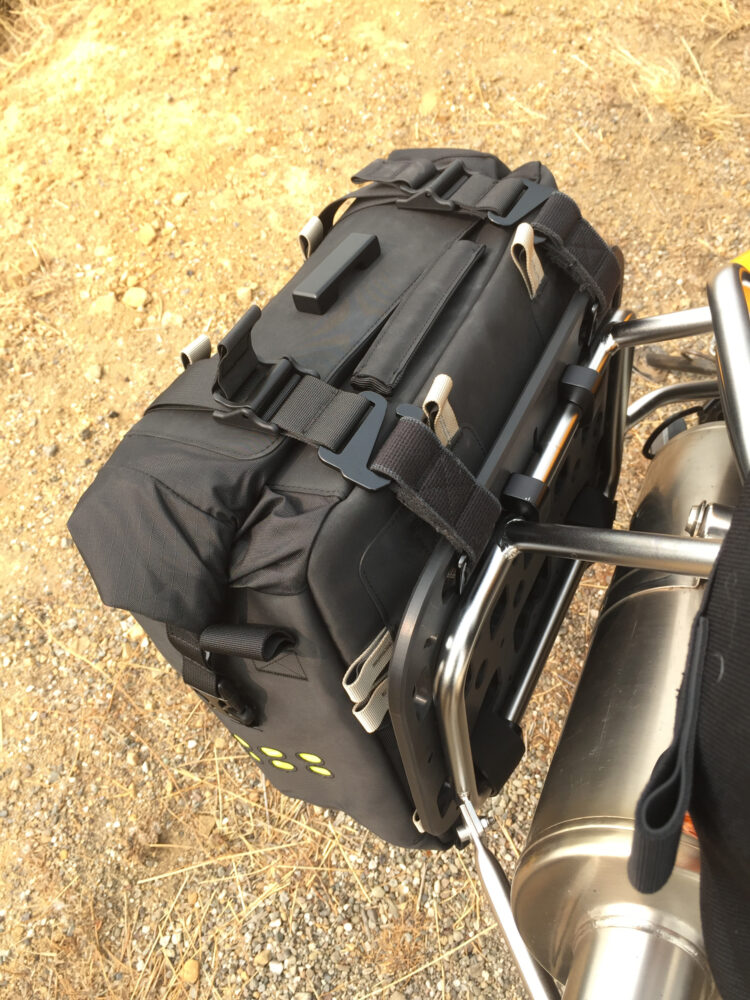
Left: Kriega’s nylon platforms provide secure attachment points for their luggage, and are also designed to carry RotoPax containers.
Right: The Kriegas use two wide straps with G-hooks to both attach the bags and close them. Nylon platforms clamped to a luggage rack are the most secure mounting option; Kriega’s OS-Base straps are an alternate method.
Using Kriega’s instructions, the platforms were quickly fastened to the rack with four single-bolt clamps. Likewise, the 32s are simple to attach to the platforms using the top and bottom G-hooks on two wide straps that close across the roll top. Access requires releasing the buckles on those straps, undoing the top hooks, and opening the roll-top buckles—easier done than said. Integrated grab handles made full panniers a cinch to mount and carry. Interference from straps and luggage is unlikely with Kriega’s two-strap design and the ability to choose a sufficiently rearward luggage position. They lack strap keepers, but any surplus can be stuffed into the strap slots.
Packing the 32s is like packing a small, vertical suitcase; my BDR gear easily fits into the available 76 liters. A chair, extra layer, snacks, and first aid kit rode in the OS-12, with the remainder balanced between the larger bags. My 16-inch tent poles just fit; anything longer would have to ride externally. Overall, the Kriegas are a neat, tidy, and rugged solution to carrying adventure gear. Made in Vietnam, they have a 10-year workmanship and material guarantee.
$600/OS-32 PANNIER SET, $218/OS PLATFORMS, $105/OS-12 ADVENTURE PACK | KRIEGA.US
Mosko Moto | Reckless 80L (V3.0) Revolver
Mosko Moto’s Reckless is a modular system offered in several configurations, ranging from ultralight to RTW; this review addresses the standard version. The 1680D nylon covers the stiff polyethylene core of the R80 harness, which is strengthened with aluminum bars. It also incorporates a removable EVA foam base and rear fueling hole. Mounted to the harness are two holsters for the included 25-liter dry bags, and a beavertail comprising two overlapping flaps that grasp Mosko’s 22-liter Stinger dry bag. Auxiliary pockets (Aux Pox) holding 4-liter dry bags piggyback on the holsters. The structural components are crafted from 1680D nylon, with wrapped edges, rivets in stress areas, and Hypalon armor. Mosko uses 800D polyurethane-coated material for the welded dry bags, which feature light blue interiors. A tent pole bag, lightweight 20-liter dry sack, heat shield, and hardware for assembling the R80 round out the kit.
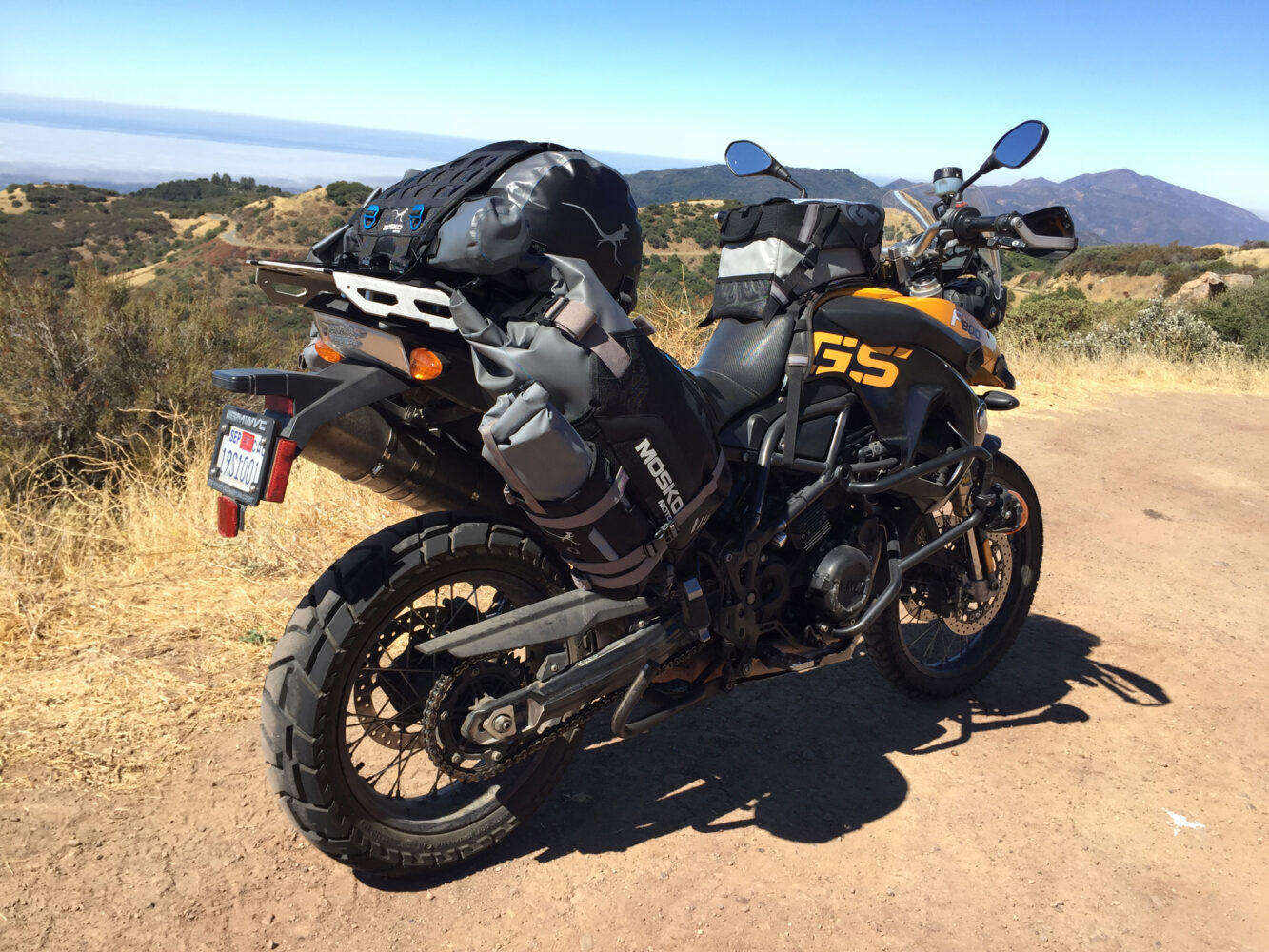
The latest Reckless 80L system from Mosko Moto incorporates adjustable holsters, removable auxiliary pockets, and replaceable straps.


Left: Three straps lash the rear of the harness to a rack plate, pulling against two forward straps to ensure the Reckless stays in place.
Right: The Revolver gets its name from the numerous side holster positions available for tailoring fit to bike and rider.
The “Revolver” part of the name refers to rider-selectable angle options for joining the holsters to the harness. Compass-like guides on the harness line up pre-drilled holes in both components for bolting on the holsters using T-nuts, screws, and washers. Once an angle was chosen, assembly was straightforward. Fitting the Aux Pox to the holsters was not—stiff fabric had to be pushed aside to align holes while mating a screw and nut inside a narrow bag. The V2.0 Reckless I carried on my Suzuki DR-Z 400S for the Idaho BDR had 4-liter pockets sewn to each holster; the Aux Pox added flexibility, as well as four more straps to the 22-strap system. Of those, two exit the lower end of the holsters to cinch the harness to a passenger footpeg or the subframe, and three hold the rear to the rack plate, cementing the R80 to the bike. The remaining straps keep things in place and unitize the system, fastening with side-release buckles or G-hooks; most have Velcro strap retainers to keep the load neat and safe. The Reckless works well, taking hard riding in stride, never budging or bouncing in the ruttiest, rockiest conditions. It weighs 15.7 pounds and measures 36 inches wide on my GS.
Packing the R80 was simple: the Stinger held my entire sleeping kit, and my chair fits perfectly in an Aux Pox, with everything else distributed evenly based on weight and need. The dry bags are easy to remove and carry to a motel room, 85 leaving the harness locked to the bike with an optional cable. Reholstering them can be a chore, even using the bottom grab handles. Partially unpacking, pushing in the bag, then repacking was easier. The waterproof Reckless is made in Vietnam and carries a limited lifetime warranty for sewn bags, two years for welded ones.
$745 | MOSKOMOTO.COM
Touratech | Extreme Waterproof Saddlebags And Adventure Dry Bag
Touratech’s entry is the smallest set of saddlebags, just 20 liters each, requiring the largest support unit at 31 liters to reach target capacity. It should be no surprise that this rackless German-made luggage from a well-respected purveyor of adventure gear is of excellent quality. The Extremes are constructed from a three-layer fabric that keeps them light yet durable. A rubberized polymer is used on the outside for UV protection, waterproofing, and abrasion resistance; inside is welded yellow vinyl that provides more waterproofing and a smooth interior surface. Sandwiched between the two is 1000D nylon mesh to prevent tearing. The backs have edge-wrapped, sewn-on dense foam pads to protect bodywork.
The pair weighs 4.5 pounds and is narrow at 35 inches across my GS. The Extremes mount with long straps and metal buckles at the front, two over-the-seat straps, and an over-the-fender clamping strap connecting the bags at the rear. The rear clamps didn’t fit the bulky GS fender well but did stay in place over challenging roads. Compression straps run back to front over the boot-shaped Extremes to further secure loads, and roll tops with four side-release buckle straps keep them watertight. With very few straps, and the ability to loosen but not release the compression straps, access to the bags is as straightforward as mounting them, and no straps are left dangling. Collapsible pockets on the back of the Extremes hold water or fuel bottles at the ready. Fitment to my GS required a heat shield, which is not included.
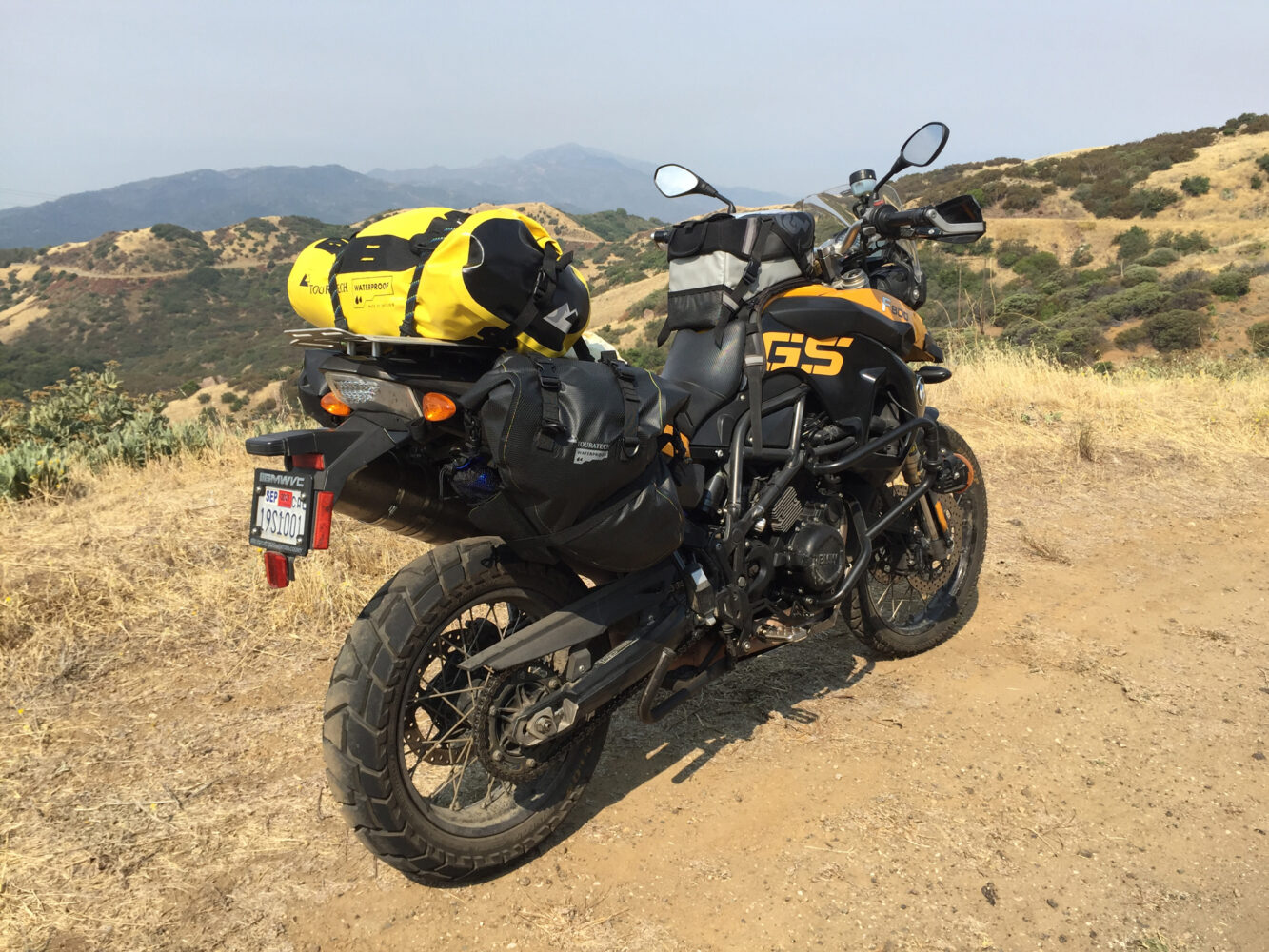
Touratech’s Extremes are the lightest of the test and hold the least gear, but are ably supplemented by the Adventure dry bag.
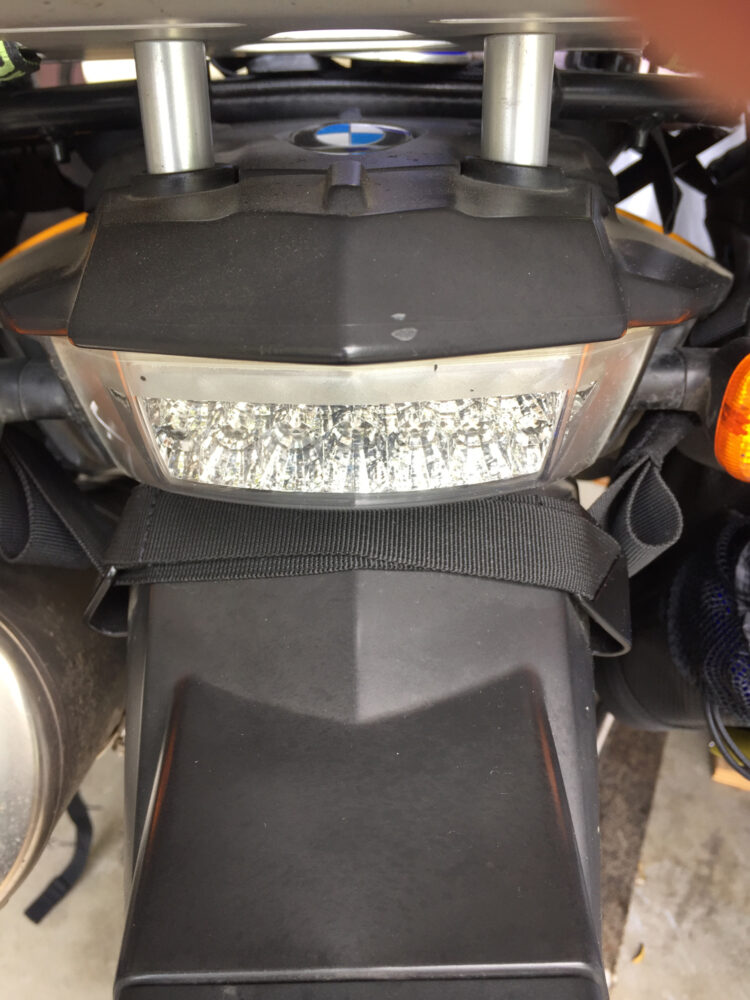
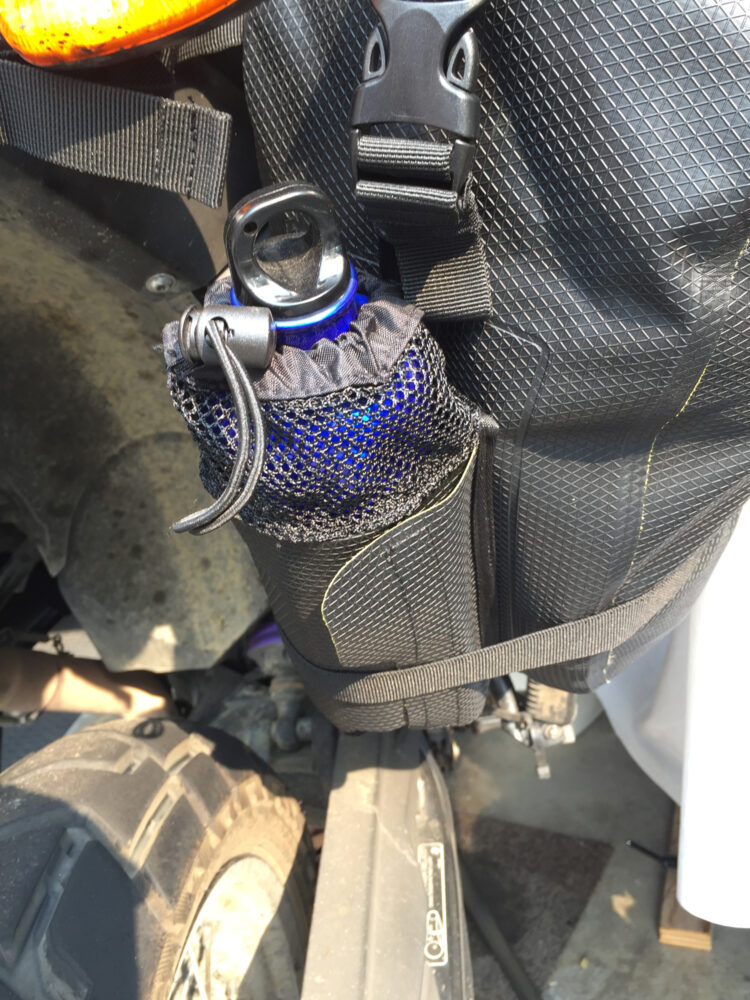
Left: While the metal clamps on the rear strap aren’t a perfect fit for the GS fender, they held tight through rough going.
Right: The Extremes feature an external collapsible pocket for keeping water or fuel bottles handy.
Waterproof specialist Ortlieb makes Touratech’s Adventure dry bag, one of the few items in this review that comes in several colors—six in all. RF welded from a PVC-coated polyester fabric, the Adventure has an IP64 ingress protection rating (dustproof, water spray). Stiffeners along the full-length roll top facilitate a tight closure, while straps at the sides and over the top ensure it remains that way. Packed with my entire sleeping setup, clothes, and a camp jacket, it was secured to the rack using Touratech’s recommended Rok straps. The Adventure’s 1.8 pounds brings the total kit weight to just 6.3 pounds; it is 35 inches wide.
Packing the non-stiffened Extremes was hampered initially by their floppy sides, but they held the remainder of my gear with room to spare. The boot shape facilitated packing heavy items low and forward, and their small size and carrying handles make them the easiest to remove and remount. On the road—whatever the surface—they never budged or interfered; ditto the dry bag. Touratech’s lightweight luggage is a good value and carries a 5-year warranty against manufacturing defects.
$400/SADDLEBAGS; $115/DRY BAG | TOURATECH-USA.COM
Wolfman | Rocky Mountain Expedition Saddlebags and Rolie Bag
Based in Longmont, Colorado, Wolfman has created textile adventure luggage since 1992. Their earlier bags, like the Alfa model I tested when KLR650s owned the back roads, were sewn from sturdy fabrics but required a rain cover. Eric Hougen, Wolfman’s owner and designer, later pioneered making waterproof luggage with vinyl fabrics. Today’s waterproof, rack-mounted Rocky Mountain Expedition saddlebags are radio-frequency (RF) welded from laser-cut 840 denier nylon/TPU laminate custom-made in China to Hougen’s specs. The smooth, black material gets hot in the sun, but doesn’t hold dust and mud like woven fabric; water rolls right off.
The roll-top Expeditions hold 30 liters each, with another 2 liters possible by omitting a roll on the top (three rolls maximize waterproofing). A 12-liter (medium-sized) Rolie bag of the same material brings total capacity into the target range. Strapped to the rack plate, it held my sleeping bag, mattress, and tent. The balance of my gear, including food for three days, disappeared into the yellow-lined Expeditions with space for more. Removable plastic stiffeners facilitate packing and maintain their wind-cheating shape.
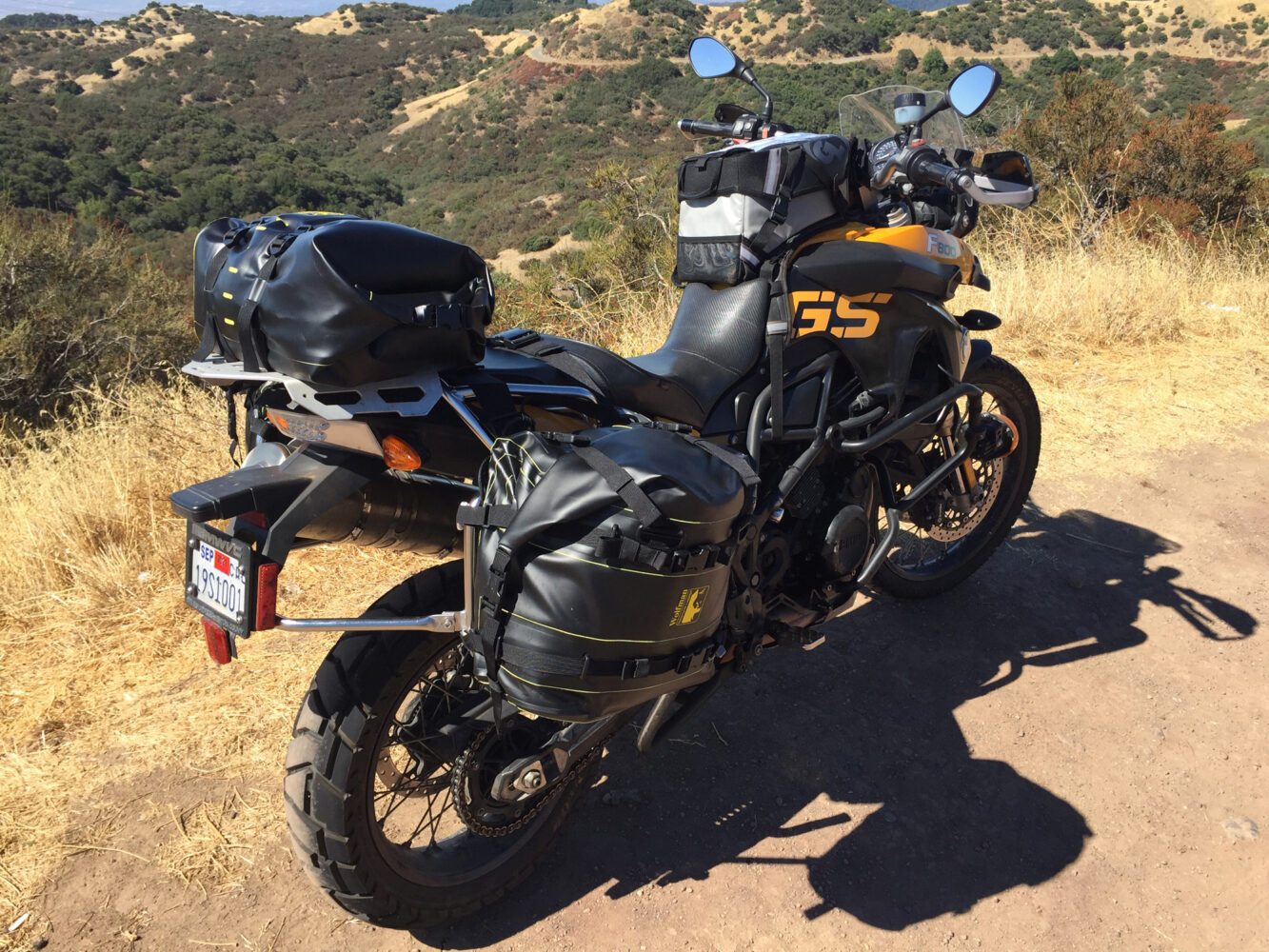
Constructed from a custom material designed by Wolfman, these rack-mounted Rocky Mountain Expedition saddlebags feature a unique curved surface and easy access to the yellow interior.
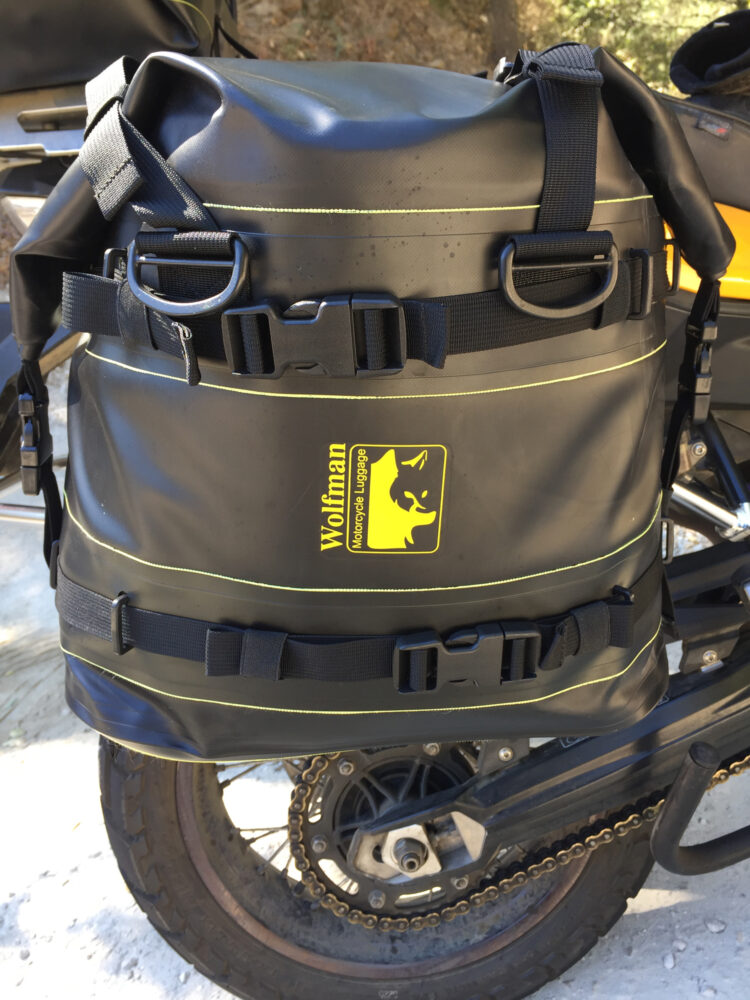
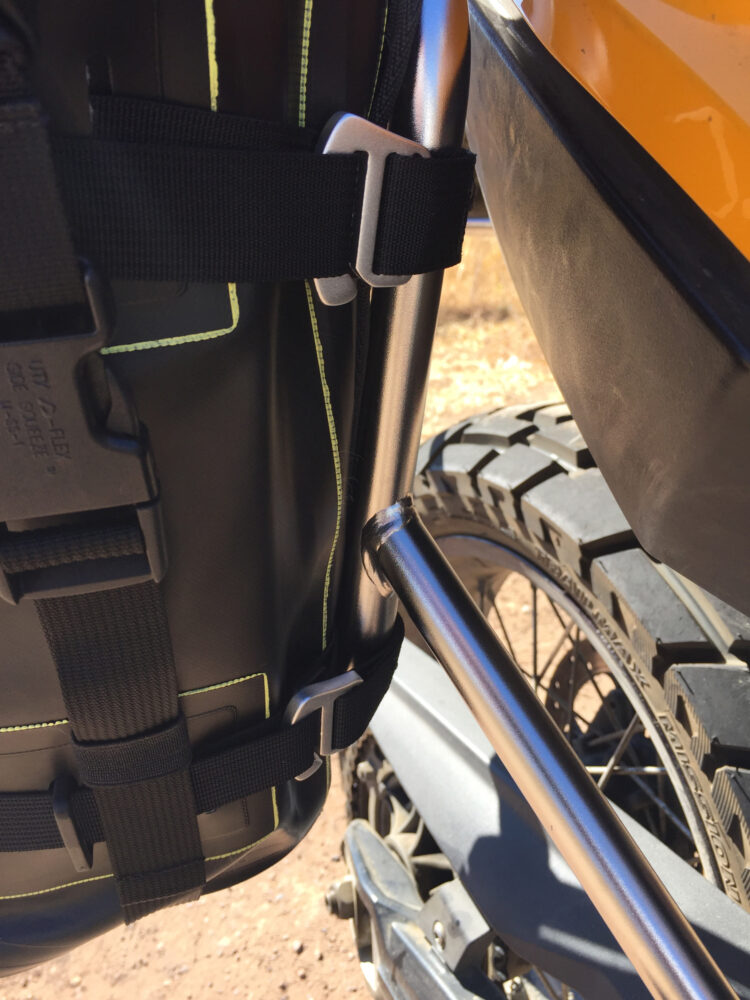
Left: Their waterproof Rolie bags come in three sizes.
Right: G-hook straps hold the Expeditions to the rack and compress the load while two straps over the seat assist in supporting its weight. External D-rings provide attachment points for extra gear and accessories.
Mounting the Expeditions is simple: two over-the-seat straps center them, adjust their height, and distribute weight, and two horizontal straps with G-hooks secure the bags to the rack. Removable back panels protect them from scuffing, and lightweight handles simplify lifting and carrying. The roll tops fasten with 1-inch side-release buckles on the sides and across the top, while the G-hook straps compress and stabilize the load. Wolfman’s attention to detail shows in the straps: most are replaceable, and all have rolled and sewn ends to inhibit fraying. Wolfman fits elastic keepers to control flapping and interference.
The Expeditions were unnoticeable on the pavement, hugging the motorcycle like they were welded to it, never upsetting the bike through the turns. Miles of rough road failed to budge the gear, and my stash of snacks was just four buckles away. Removing and re-mounting the full Expeditions was more difficult than when empty, but the handles and seat straps made it workable. The Rolie bag stayed put as well, barely noticeable on the top rack. The setup weighs 10 pounds, plus 9 pounds for the rack, and stretches 41 inches across my GS. Wolfman continues to innovate in both material and design, providing an excellent, reasonably priced set of luggage for the adventurer, covered by a 1-year limited warranty.
$475/SADDLEBAGS; $105/ROLIE BAG | WOLFMANLUGGAGE.COM
Touratech Stainless Steel Pannier Rack
As a long-time adherent to the light-is-right approach to adventure riding, I’ve always looked askance at racks, mostly for the significant weight they add to a motorcycle. After all, they are steel and built for strength. The Touratech unit I sourced for this review is no exception—constructed of 18-millimeter tubular stainless steel, it weighs in at 9 pounds. I’ve come to like it, however, as it provides a better grab bar for hefting the bike onto the center stand than BMW did, and performed as required for testing the Wolfman and Kriega luggage.
Installing the three-piece system went quickly, requiring only a few basic tools. Two forward side sections clamp to the 800’s subframe, with the upper supports bolting to the original grab bar mounting holes. A third piece connects the two sections at the rear. All of the holes lined up properly, with no need to force the fit. The resulting structure is stiff, sturdy, and appears ready to take adventure-style punishment. On the GS, a rack plate can also be fitted but is not required to complete the installation. Made in Germany, the Touratech rack comes in the raw stainless shown or epoxy-coated black.
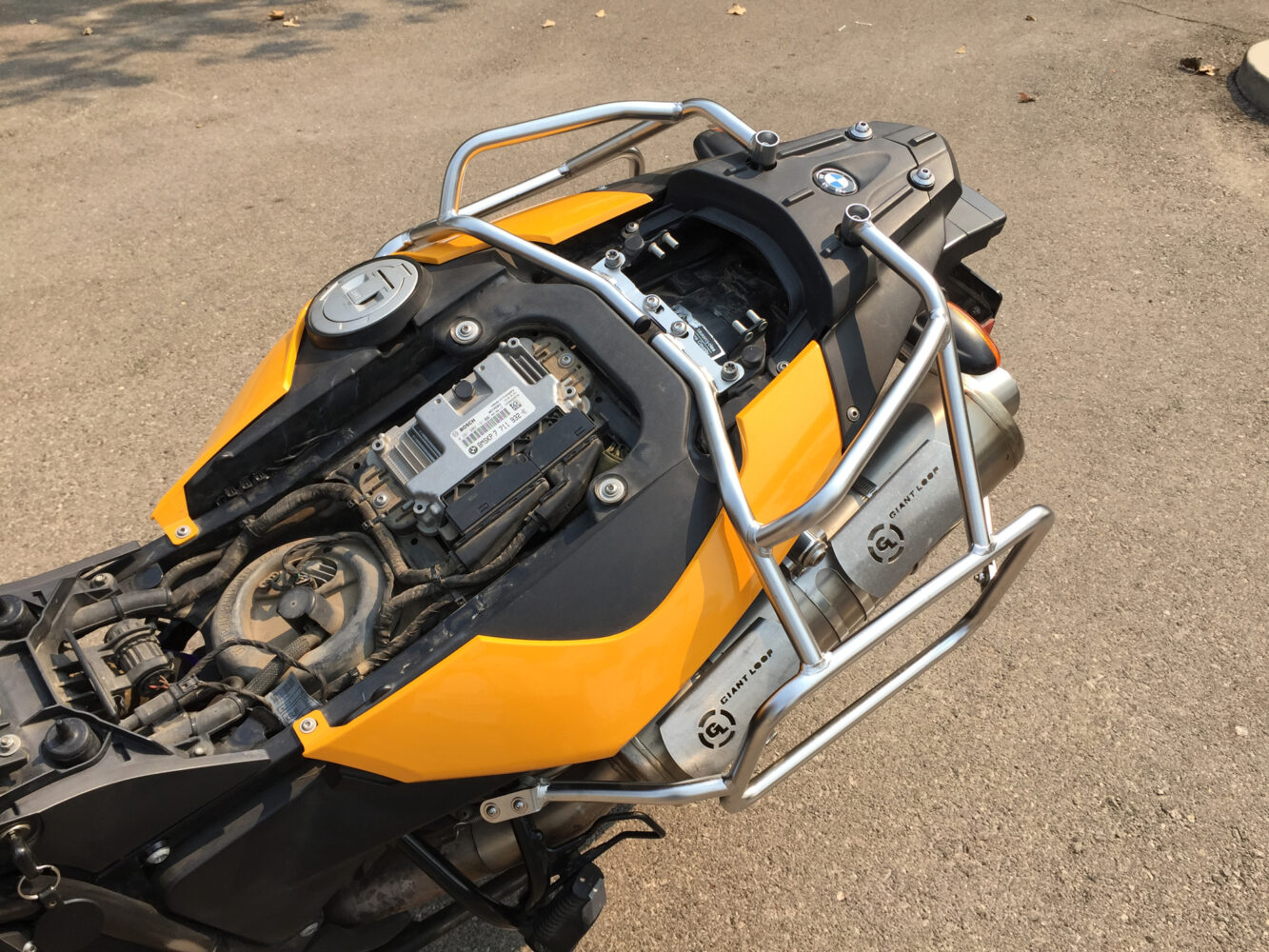
A feature of racks is preventing bodywork from getting scuffed up by panniers. Despite my efforts to prevent damage from rackless luggage with films and tape, the thousands of miles I’ve ridden my GS with such bags are indelibly recorded in the bike’s rear plastics. As tempting as this attractive and functional rack is, I’m still a stickler about weight and will likely remain a devotee of rackless luggage to save a few pounds. My weight obsession aside, anyone shopping for a rack should consider Touratech’s offering.
$400 | TOURATECH-USA.COM
Conclusions
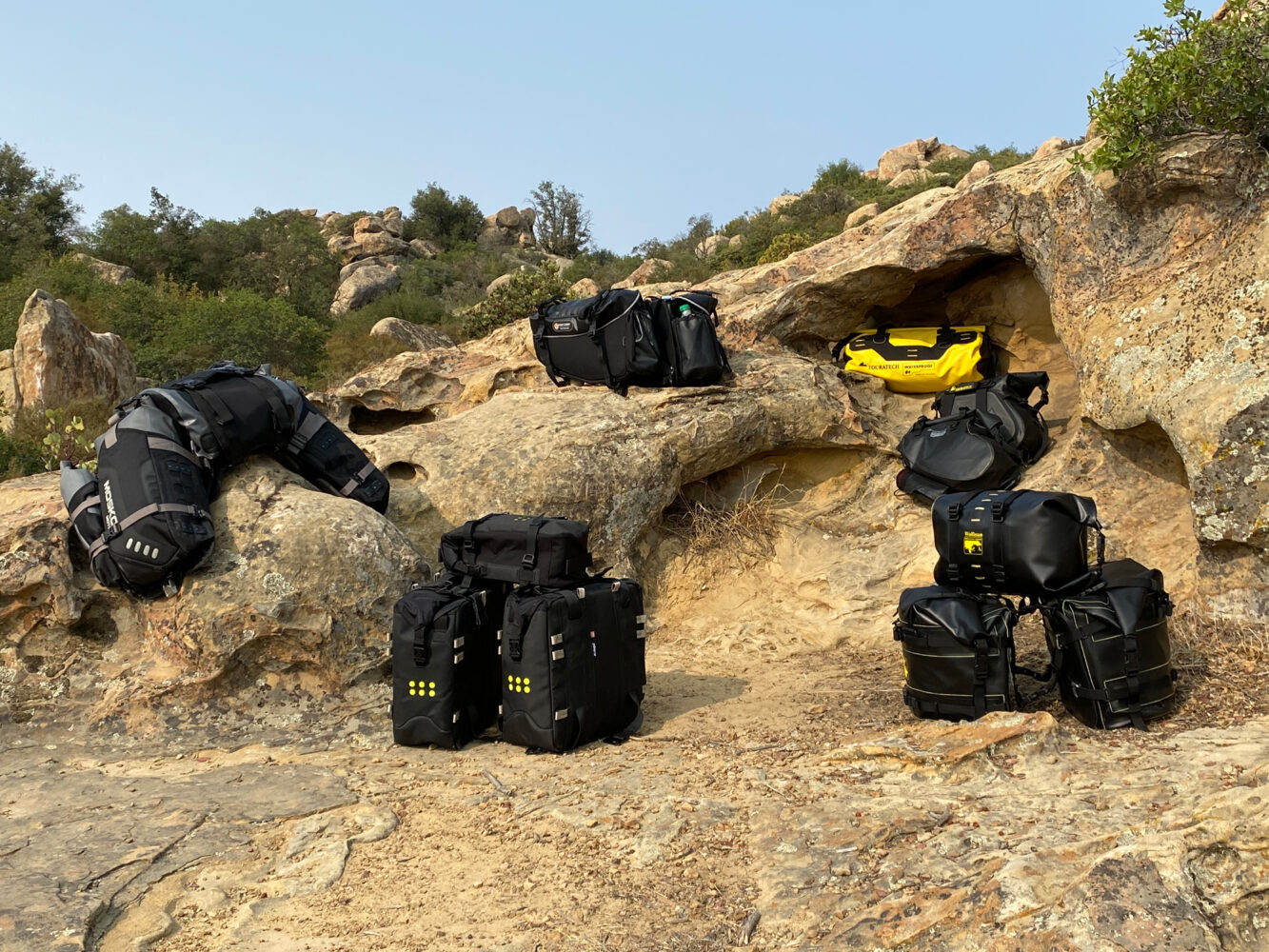
Clockwise from left: Mosko Moto Reckless 80L (V3.0) Revolver, Giant Loop Siskiyou, Touratech Extreme, Wolfman Rocky Mountain Expedition, Kriega Overlander-S OS-32 and OS-12.
This wouldn’t be a Best of Breed if all of the bags didn’t meet the criteria, and since all have something unique to offer, it’s up to each adventurer looking at soft luggage to assess how much capacity they require and in what format. Fortunately, for those who need more space, all of the systems can be supplemented with extra storage, and most are designed to easily accommodate it. The low-weight leaders— important to me as a smaller rider—are Touratech and Giant Loop. Giant Loop’s construction seems heavier duty, while the Touratech package is narrower but stores more weight up higher. It is also the least expensive solution. Mosko’s Reckless is heavier than both, which should translate into durability, but adds complexity with a raft of straps. I vote it best for pitching off the road onto a pile of rocks (been there, done that). Wolfman and Kriega both take a 9-pound rack penalty, with Kriega also being the most expensive set. Wolfman keeps things simple, clean, and easy to use for slightly more money than the Touratech Extremes. There’s not a luggage system here that I wouldn’t trust on a rainy ride, or for seeing me through a BDR. What’s the best setup? I prefer the Touratech Extremes and Adventure Dry Bag; it is the lightest system in the group and the least expensive.
Editor’s note: This article was originally published in Overland Journal’s Gear 2021 Issue.
Our No Compromise Clause: We carefully screen all contributors to make sure they are independent and impartial. We never have and never will accept advertorial, and we do not allow advertising to influence our product or destination reviews.


